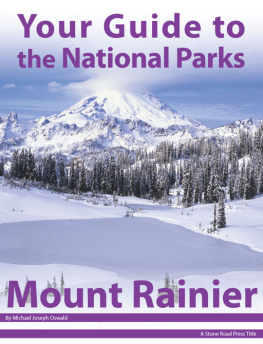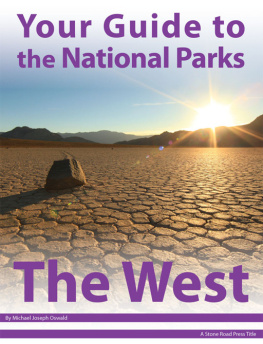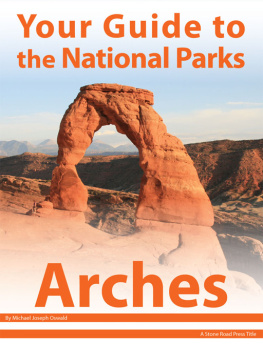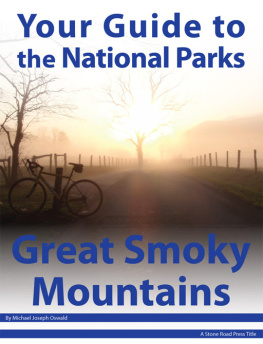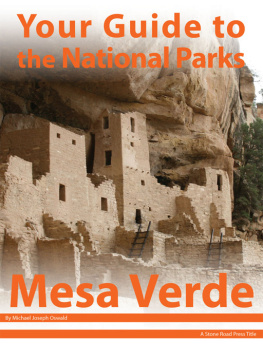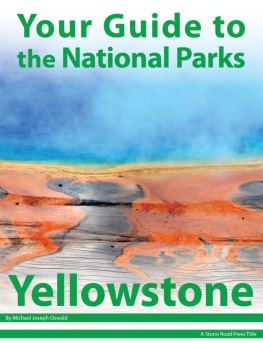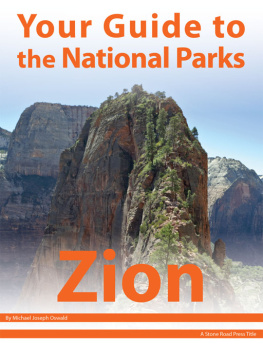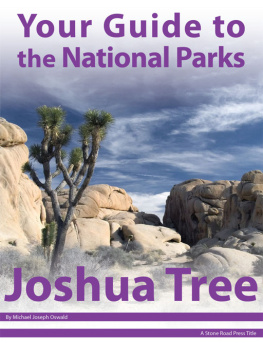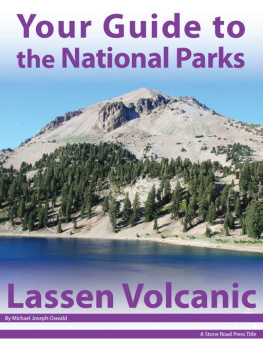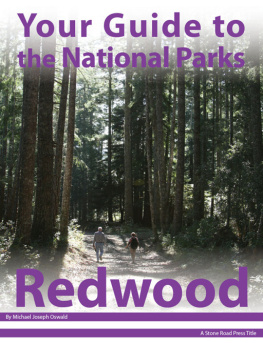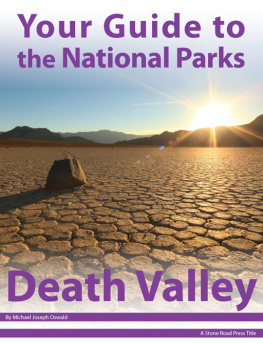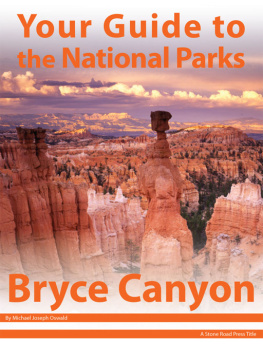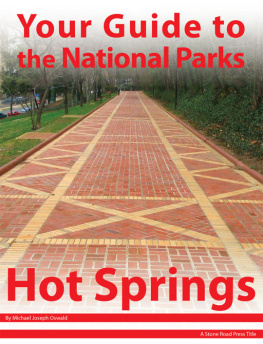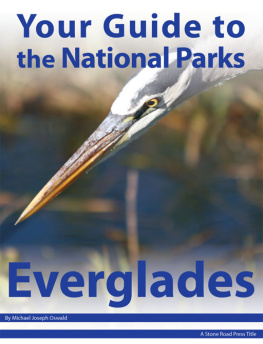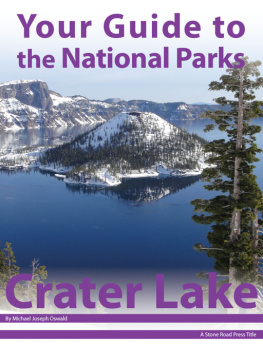Your Guide to Mount Rainier National Park, First Edition (electronic)
ISBN: 978-1-62128-043-9
Published by: Stone Road Press
Author/Cartographer/Photographer/Designer: Michael Joseph Oswald
Editor: Derek Pankratz
Copyright 2012 Stone Road Press, LLC, Whitelaw, Wisconsin. All rights reserved. No part of this publication may be reproduced, stored in a retrieval system or transmitted in any form or by any means, electronic, mechanical, photocopying, recording, scanning or otherwise without written permission of the Publisher. Requests for permission should be addressed to Stone Road Press; c/o Michael Oswald; 4927 Stone Road; Whitelaw, WI 54247.
The entire work, Your Guide to the National Parks is available in paperback and electronic versions. Content that appears in print may not be available electronically.
Paperback ISBN: 978-1-62128-000-2
Library of Congress Control Number (LCCN): 2012934277
Printed in the United States of America
E-Book ISBN: 978-1-62128-0 65-1
Corrections/Contact
This guide book has been researched and written with the greatest attention to detail in order to provide you with the most accurate and pertinent information. Unfortunately, travel informationespecially pricingis subject to change and inadvertent errors and omissions do occur. Should you encounter a change, error, or omission while using this guide book, wed like to hear about it. (If you found a wonderful place, trail, or activity not mentioned, wed love to hear about that too.) Please contact us by sending an e-mail to . Your contributions will help make future editions better than the last.
You can contact us online at www.StoneRoadPress.com or follow us on
Facebook: www.facebook.com/thestoneroadpress
Twitter: www.twitter.com/stoneroadpress (@stoneroadpress)
Flickr: www.flickr.com/photos/stoneroadpress
FAQs
The world of electronic media is not cut and dry like print. Devices handle files differently. Users have a variety of expectations. These e-books are image- and map-intensive, requiring fairly powerful hardware. All books were tested for use on the Kindle Fire, Nook Tablet, and iPad. You can expect to have the best user experience on one of these devices, or a similar tablet, laptop, or desktop. In the event you have issues please peruse our Frequently Asked Questions (.
Maps
Numerous map layouts were explored while developing this e-book, but in the end it was decided that the most useful map is a complete one. Unfortunately, due to file size concerns and e-reader hardware limitations, some maps included in this guide book are below our usual high standards of quality (even using zoom features). As a workaround all of this books maps are available in pdf format by clicking the link below each map or visiting www.stoneroadpress.com/national-parks/maps .
Disclaimer
Your safety is important to us. If any activity is beyond your ability or threatened by forces outside your control, do not attempt it. The maps in this book, although accurate and to scale, are not intended for hiking. Serious hikers should purchase a detailed, waterproof, topographical map. It is also suggested that you write or call in advance to confirm information when it matters most.
The primary purpose of this guide book is to enhance our readers national park experiences, but the author, editor, and publisher cannot be held responsible for any experiences while traveling.
Photo Credits
Front cover: Mount Rainier viewed from Upper Tipsoo Lake near Chinook Pass Shutterstock
Mount Rainier - Introduction
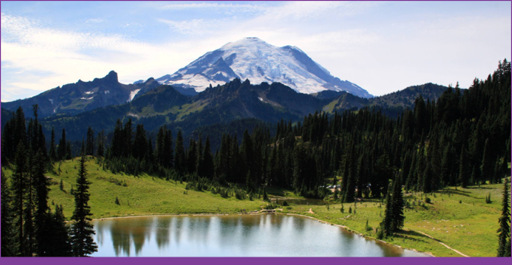
Mount Rainier viewed from Upper Tipsoo Lake near Chinook Pass Frank Kovalchek
Mount Rainier , the 14,410-foot volcano, towers above its surroundings and greets visitors from all directions more than 100 miles before entering the park boundary. Cowlitz, Nisqually, Puyallup, and Yakima tribes called the mountain Tahoma or the Big Mountain where the waters begin. Much more than water begins here. Natives began vision quests at this location. Todays guests search for respite begins and ends at majestic Mount Rainier. Nearly 1.5 million visitors admire these mountain views each year, and some 10,000 climbers attempt to trek to its summit, where they are able to look down on 26 glaciers covering its upper reaches and to the Pacific Northwest beyond.
The snow-capped mountains dramatic presence caught the attention of several groups and soon commercial interests and conservationists were mired in a contentious debate over the best way to utilize the area. In 1893, federal government officials created the Pacific Forest Reserve , encompassing the mountain. Gifford Pinchot , head of the United States Forest Service, believed in conservation through use, treating the nations forests like a crop to be maintained and used. John Muir , a beloved naturalist who had successfully advocated for the preservation of Yosemite Valley, formed a kinship with Mount Rainier in 1888 when he joined a group that completed the mountains 5th recorded ascent. He wrote in a letter to his wife that he had absolutely no intention of climbing the mountain, but when five others showed interest in the idea he couldnt help but tag along. Muir vehemently opposed the conservation through use idea. Not a single tree would fall at the hands of an ax or river be impeded by a dam if he had his way. Preservation, plain and simple, was his goal. These sublime works of nature were beyond the scope of anything man could ever make in terms of beauty and grandeur. They needed to be preserved and protected for the enjoyment of all, not looted and plundered for the benefit of private interests. Support from influential bodies with interests of their own helped galvanize the conservationist movement. The National Geographic Society wished to study volcanism and glaciology in the area. The Northern Pacific Railroad was on board because a park could draw more passenger service on their trainsa tried and tested method that already yielded substantial benefits for Northern Pacific and Southern Pacific Railroads with the creation of Yellowstone and Yosemite National Parks, respectively. The Sierra Club and commercial leaders in Tacoma and Seattle joined the cause, supporting what would become a long and arduous battle. Over the course of five years of bitter debate and six attempts, a bill was finally passed with two provisions: the government needed assurances that no park land was suitable for farming or mining and that no government appropriations were required for its management and procurement. The provisions were met, and on March 2, 1899 Mount Rainier became the fifth national park and first to be created from a national forest.
Park establishment and construction of a road to Paradise in 1911 ushered in a new era of tourism. President William Howard Tafts touring car was the first vehicle to christen the road in very unique fashion: muddy conditions resulted in his car being pulled through the upper portion by a team of mules. Six years later the National Park Service was established and trails, facilities, roads, and campgrounds were developed in earnest, enhancing the overall visitor experience. Mountain climbers could experience summiting Rainier much like John Muir did, and now thousands of climbers make the trek each year. Todays visitors realize what Muir and Native Americans knew: Mount Rainier is more than a pleasure ground, its a sacred place in need of preservation and protection.
Park Shuttle (MORA)
The Upper Paradise lot is intended for short-term parking and it usually fills before noon on weekends. The Lower Paradise lot is intended for stays longer than two hours. Paradise Shuttle helps reduce congestion and air pollution by providing free transportation between Longmire and Paradise. Stops are also made at Cougar Rock Campground, Narada Falls (when traveling to Paradise), and Comet Falls (when traveling from Paradise). Shuttles stop at each scheduled location every 45 minutes on Fridays and every 15 25 minutes on Saturdays and Sundays from mid-June through early September. The Shuttle does not run Monday through Thursday. Service begins at Longmire at 10am, and the last bus leaves Paradise at 7pm.
Next page
